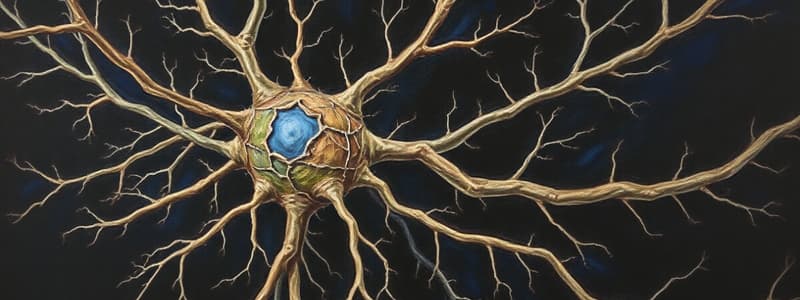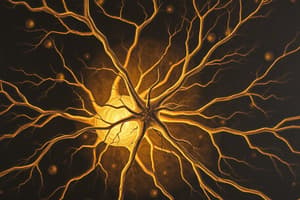Podcast
Questions and Answers
What is the diameter of most neurons in the human nervous system?
What is the diameter of most neurons in the human nervous system?
- 0.08 mm
- 0.01 mm
- 0.02 mm (correct)
- 0.04 mm
Which type of neuron is responsible for sending signals from the brain to muscles?
Which type of neuron is responsible for sending signals from the brain to muscles?
- Interneurons
- Sensory neurons
- Dendritic neurons
- Motor neurons (correct)
What are the two main types of cells in the nervous system?
What are the two main types of cells in the nervous system?
- Neurons and skeletal cells
- Sensory cells and glia
- Neurons and glia (correct)
- Motor neurons and interneurons
What role do interneurons play within the central nervous system?
What role do interneurons play within the central nervous system?
Which statement about the neuron theory is true?
Which statement about the neuron theory is true?
What technique did Santiago Ramón y Cajal use to trace connections in the brain?
What technique did Santiago Ramón y Cajal use to trace connections in the brain?
Which part of the neuron is responsible for receiving signals?
Which part of the neuron is responsible for receiving signals?
How many neurons are estimated to be in the human nervous system?
How many neurons are estimated to be in the human nervous system?
What is the primary function of glial cells in the nervous system?
What is the primary function of glial cells in the nervous system?
How are molecules formed?
How are molecules formed?
What charge do protons carry?
What charge do protons carry?
What is a characteristic of water as a molecule?
What is a characteristic of water as a molecule?
What role does the cell membrane play in a neuron?
What role does the cell membrane play in a neuron?
How many chromosomes does a human somatic cell typically have?
How many chromosomes does a human somatic cell typically have?
What does a gene encode?
What does a gene encode?
What is the basic function of astrocytes in the nervous system?
What is the basic function of astrocytes in the nervous system?
What is the primary function of the sequence of ACTG base pairs in DNA?
What is the primary function of the sequence of ACTG base pairs in DNA?
What does epigenetics study?
What does epigenetics study?
What term describes an individual with two different alleles for the same trait?
What term describes an individual with two different alleles for the same trait?
Which condition is caused by a recessive allele?
Which condition is caused by a recessive allele?
What is a dominant allele?
What is a dominant allele?
What type of disorder is Huntington's disease classified as?
What type of disorder is Huntington's disease classified as?
At what age do symptoms of Tay-Sachs disease typically appear?
At what age do symptoms of Tay-Sachs disease typically appear?
Which of the following describes the function of Golgi bodies in protein processing?
Which of the following describes the function of Golgi bodies in protein processing?
What is typically the genetic cause of Down syndrome?
What is typically the genetic cause of Down syndrome?
Which of the following is NOT an approach to genetic engineering?
Which of the following is NOT an approach to genetic engineering?
What is the primary purpose of cloning in genetics?
What is the primary purpose of cloning in genetics?
What does knock-in technology accomplish?
What does knock-in technology accomplish?
Which of the following is a feature of CRISPR technology?
Which of the following is a feature of CRISPR technology?
What does phenotypic plasticity refer to?
What does phenotypic plasticity refer to?
What is one of the implications of less than perfect concordance rates between twins for certain diseases?
What is one of the implications of less than perfect concordance rates between twins for certain diseases?
What condition related to Down syndrome can potentially develop due to its genetic factors?
What condition related to Down syndrome can potentially develop due to its genetic factors?
Flashcards are hidden until you start studying
Study Notes
Cells of the Nervous System
- Neurons are the functional units of the nervous system
- Neurons vary in size and shape, but all have a common plan
- Neurons have an average diameter of 0.02mm
- The human nervous system contains approximately 86 billion neurons
- Glial Cells are the support cells of the nervous system
- There are approximately 87 billion glial cells in the human nervous system
The Neuron Theory
- The neuron theory proposes that neurons are the functional units of the nervous system and that interactions between neurons enable behavior.
- The complexity of an organism’s behavior is determined by the number of neurons it has.
- The Golgi stain (invented by Camillo Golgi) was crucial for gaining an understanding of neuron structure and function.
- Santiago Ramon y Cajal used the Golgi stain to trace connections of the brain for over 25 years.
Neuron Structure
- Dendrite: Receives information from other neurons
- Cell Body: Contains the nucleus and other organelles; integrates signals
- Axon hillock: Point where the axon emerges; initiates action potentials
- Axon: Carries information away from the cell body; transmits signals
- Axon collateral: Branch of an axon
- Telodendria: Fine branches at the end of an axon
- Terminal button: Knob-like structure at the end of an axon; releases neurochemicals into the synapse
- Synapse: Junction between the axon terminal and the dendrite of another neuron
Types of Neurons
- Sensory Neurons: Carry information from sensory receptors to the spinal cord
- Interneurons: Connect neurons within the central nervous system
- Motor Neurons: Send signals from the brain and spinal cord to muscles
Communication between Neurons
- The input-association-output model describes how neurons function in networks
- Communication between neurons is through excitation and inhibition
- Excitation increases the activity of a neuron
- Inhibition decreases the activity of a neuron
Glial Cells
- There are five major types of glia
- Glia help neurons deliver messages and provide structural support to the nervous system
Internal Structure of a Cell: Chemistry Review
- Elements are naturally occurring substances
- Atoms are the smallest unit of an element with the properties of that element
- Atoms contain a nucleus ( protons with a positive charge, neutrons with a neutral charge) and electrons with a negative charge.
Internal Structure of a Cell
- Cell Membrane: Surrounds the contents of the cell and regulates movement of substances into and out of the cell.
- Nucleus: Contains the genetic material, DNA, responsible for protein synthesis.
The Nucleus & Protein Synthesis
- Genes are segments of DNA that encode the synthesis of a particular protein
- Chromosomes contain genes
- Each chromosome contains thousands of genes
- A human somatic (body) cell has 23 pairs of chromosomes (46 total)
- A reproductive cell (sperm, egg) has 23 chromosomes.
- DNA is composed of nucleotides with four bases: Adenine (A), Thymine (T), Guanine (G), and Cytosine (C)
- The sequence of bases in DNA determines the order of amino acids in proteins
Protein Packaging & Shipping
- Ribosomes translate mRNA into protein chains
- Golgi Bodies modify and package proteins for export from the cell
- Microtubules transport molecules through the cell
Genes, Cells, & Behaviour
- Mendelian Genetics: The study of how genes influence traits
- Genotype: The genetic makeup of an individual
- Phenotype: The observable physical and behavioral characteristics of an individual
- Epigenetics: The study of environmental factors that can influence gene expression
Chromosomes & Genes
- Alleles: The two copies of a gene
- Dominant allele: The allele that is routinely expressed
- Recessive allele: The allele that is routinely not expressed
- Homozygous: Having two identical alleles for a trait
- Heterozygous: Having two different alleles for a trait
Genetic Disorders
- Tay-Sachs disease: Inherited birth defect caused by the loss of genes that encode an enzyme required for breaking down fatty substances
- Huntington’s disease: Autosomal disorder caused by an increase in CAG repeats on chromosome 4
- Down syndrome: Caused by an extra copy of chromosome 21 (trisomy), can result in intellectual impairment, heart defects, leukemia, and Alzheimer's disease.
Genetic Engineering
- Genetic engineering: Modification of a gene
- Selective breeding: Selectively breeding organisms for desirable traits
- Cloning: Producing offspring genetically identical to another organism
- Transgenic techniques: Introduction of genes from one species into the genome of another species
CRISPR
- CRISPR: A technology that allows for precise editing of DNA sequences
Phenotypic Plasticity & The Epigenetic Code
- Phenotypic plasticity: An organism’s ability to develop more than one phenotype due to the genome’s capacity to express many phenotypes and epigenetics.
- Epigenetics: The study of how environmental factors can influence gene expression
- Environmental factors can alter gene expression without changing the underlying DNA sequence.
Studying That Suits You
Use AI to generate personalized quizzes and flashcards to suit your learning preferences.




